Increased Mass Loss of Glaciers in the Sawir Mountains of Central Asia between 1959 and 2021
Abstract
1. Introduction
2. Study Site
3. Data and Methods
3.1. Geodetic Mass Balance
3.1.1. Digital Elevation Models (DEMs)
3.1.2. Geodetic Mass Balance Calculation
3.1.3. Uncertainty Assessment
3.2. Glaciological Mass Balance
3.3. Glacier Area
3.4. Meteorological Data
4. Results
4.1. Glacier Area Change
4.2. Changes in Glacier Surface Elevation and Geodetic Mass Balance (1959–2021)
4.3. Glaciological Mass Balance (2014–2021)
5. Discussion
5.1. Comparison of Geodetic and Glaciological Mass Balances
5.2. Comparison with Neighboring Mountain Glaciers
5.3. Glacier Morphology and Geometry
5.4. Climate Background
6. Conclusions
Author Contributions
Funding
Data Availability Statement
Acknowledgments
Conflicts of Interest
References
- Kaser, G.; Grosshauser, M.; Marzeion, B. Contribution Potential of Glaciers to Water Availability in Different Climate Regimes. Proc. Natl. Acad. Sci. USA 2010, 107, 20223–20227. [Google Scholar] [CrossRef]
- Gardner, A.S.; Moholdt, G.; Cogley, J.G.; Wouters, B.; Arendt, A.A.; Wahr, J.; Berthier, E.; Hock, R.; Pfeffer, W.T.; Kaser, G.; et al. A Reconciled Estimate of Glacier Contributions to Sea Level Rise: 2003 to 2009. Science 2013, 340, 852–857. [Google Scholar] [CrossRef]
- Solomina, O.N.; Bradley, R.S.; Jomelli, V.; Geirsdottir, A.; Kaufman, D.S.; Koch, J.; McKay, N.P.; Masiokas, M.; Miller, G.; Nesje, A.; et al. Glacier fluctuations during the past 2000 years. Quat. Sci. Rev. 2016, 149, 61–90. [Google Scholar] [CrossRef]
- Wang, L.; Liu, C.; Kang, X.; You, G.X. Fundamental features of modern glaciers in the Altay Mountain of China: A cast study of Halasi Glacier. J. Glaciol. Geocryol. 1983, 5, 27–38. [Google Scholar]
- Kamp, U.; Pan, C.G. Inventory of Glaciers in Mongolia, Derived from Landsat Imagery from 1989 to 2011. Geogr. Ann. Ser. A Phys. Geogr. 2015, 97, 653–669. [Google Scholar] [CrossRef]
- Shen, Y.; Su, H.; Wang, Y.; Mao, W.M.; Wang, S.D.; Han, P.; Wang, W.; Li, Z.Q. The responses of glaciers and snow cover to climate change in Xinjing (I): Hydrological effect. J. Glaciol. Geocryol. 2013, 35, 513–527. [Google Scholar]
- Li, Z.; Li, K.; Wang, L. Study on recent glacier changes and their impact on water resources in Xinjiang, northwestern China. Quat. Sci. 2010, 30, 96–106. [Google Scholar]
- Dehecq, A.; Gourmelen, N.; Gardner, A.S.; Brun, F.; Goldberg, D.; Nienow, P.W.; Berthier, E.; Vincent, C.; Wagnon, P.; Trouvé, E. Twenty-first century glacier slowdown driven by mass loss in High Mountain Asia. Nat. Geosci. 2019, 12, 22–27. [Google Scholar] [CrossRef]
- Hugonnet, R.; McNabb, R.; Berthier, E.; Menounos, B.; Nuth, C.; Girod, L.; Farinotti, D.; Huss, M.; Dussaillant, I.; Brun, F.; et al. Accelerated global glacier mass loss in the early twenty-first century. Nature 2021, 592, 726–731. [Google Scholar] [CrossRef]
- Huai, B.; Li, Z.; Wang, F.; Wang, P. Variation of glaciers in the Sawuer Mountain within Chinese territory during 1959–2013. J. Glaciol. Geocryol. 2015, 37, 1141–1149. [Google Scholar]
- Wang, Y.; Zhao, J.; Li, Z.; Zhang, M. Glacier changes in the Sawuer Mountain during 1977–2017 and their response to climate change. J. Nat. Resour. 2019, 34, 802–814. [Google Scholar] [CrossRef]
- Xu, C.; Li, Z.; Wang, F.; Mu, J. Spatio–Temporal Changes of Mass Balance in the Ablation Area of the Muz Taw Glacier, Sawir Mountains, from Multi–Temporal Terrestrial Geodetic Surveys. Remote Sens. 2021, 13, 1465. [Google Scholar] [CrossRef]
- Wang, Z. New statistical figures and distribution feature of glaciers on the various mountains in China. J. Glaciol. Geocryol. 1988, 11, 8–14. [Google Scholar]
- Shi, Y. Concise China Glacier Inventory; Shanghai Science Popularization Press: Shanghai, China, 2005; pp. 1–490. [Google Scholar]
- Wang, F.; Yue, X.; Wang, L.; Li, H.; Du, Z.; Ming, J.; Li, Z. Applying artificial snowfall to reduce the melting of the Muz Taw Glacier, Sawir Mountains. Cryosphere 2020, 14, 2597–2606. [Google Scholar] [CrossRef]
- Wang, P.; Li, Z.; Li, H.; Wang, W.; Zhou, P.; Wang, L. Characteristics of a partially debris-covered glacier and its response to atmospheric warming in Mt. Tomor, Tien Shan, China. Glob. Planet. Chang. 2017, 159, 11–24, ISSN 0921-8181. [Google Scholar] [CrossRef]
- Farr, T.G.; Rosen, P.A.; Caro, E.; Crippen, R.; Duren, R.; Hensley, S.; Kobrick, M.; Paller, M.; Rodriguez, E.; Roth, L.; et al. The shuttle radar topography mission. Rev. Geophys. 2007, 45, 1–43. [Google Scholar] [CrossRef]
- Brun, F.; Berthier, E.; Wagnon, P.; Kaab, A.; Treichler, D. A spatially resolved estimate of High Mountain Asia glacier mass balances from 2000 to 2016. Nat. Geosci. 2017, 10, 668–673. [Google Scholar] [CrossRef]
- Massonnet, D.; Feigl, K.L. Radar interferometryand its application to changes in the Earth’s surface. Rev. Geophys. 1998, 36, 441–500. [Google Scholar] [CrossRef]
- Wangchuk, S.; Bolch, T.; Zawadzki, J. Towards automated mapping and monitoring of potentially dangerous glacial lakes in Bhutan Himalaya using Sentinel-1 Synthetic Aperture Radar data. Int. J. Remote Sens. 2019, 40, 4642–4667. [Google Scholar] [CrossRef]
- Peters, M. How to Use the SNAP API from Python. 2020. Available online: https://senbox.atlassian.net/wiki/spaces/SNAP/pages/19300362/HowþtoþusetheSNAPþAPIþfromþPython (accessed on 22 July 2021).
- Nuth, C.; Kääb, A. Co–registration and bias corrections of satellite elevation data sets for quantifying glacier thickness change. Cryosphere 2011, 5, 271. [Google Scholar] [CrossRef]
- Paul, F. Calculation of glacier elevation changes with SRTM: Is there an elevation–dependent bias. J. Glaciol. 2008, 54, 945–946. [Google Scholar] [CrossRef]
- Gardelle, J.; Berthier, E.; Arnaud, Y. Impact of resolution and radar penetration on glacier elevation changes computed from DEM differencing. J. Glaciol. 2012, 58, 419–422. [Google Scholar] [CrossRef]
- Thibert, E.; Blanc, R.; Vincent, C.; Eckert, N. Instruments and Methods Glaciological and volumetric mass–balance measurements: Error analysis over 51 years for Glacier de Sarennes, French Alps. J. Glaciol. 2008, 54, 522–532. [Google Scholar] [CrossRef]
- Fischer, A. Comparison of direct and geodetic mass balances on a multi–annual time scale. Cryosphere 2010, 5, 107–124. [Google Scholar] [CrossRef]
- Nuimura, T.; Sakai, A.; Taniguchi, K.; Nagai, H.; Lamsal, D.; Tsutaki, S.; Kozawa, A.; Hoshina, Y.; Takenaka, S.; Omiya, S.; et al. The GAMDAM glacier inventory: A quality-controlled inventory of Asian glaciers. Cryosphere 2015, 9, 849–864. [Google Scholar] [CrossRef]
- Zemp, M.; Hoelzle, M.; Haeberli, W. Six decades of glacier mass-balance observations: A review of the worldwide monitoring network. Ann. Glaciol. 2009, 50, 101–111. [Google Scholar] [CrossRef]
- Wang, P.; Li, Z.; Li, H.; Yao, H.; Xu, C.; Zhou, P.; Jin, S.; Wang, W. Analyses of recent observations of Urumqi Glacier No.1, Chinese Tianshan Mountains. Environ. Earth Sci. 2016, 75, 720. [Google Scholar] [CrossRef]
- Huss, M.; Bauder, A.; Funk, M. Homogenization of long term mass balance time series. Ann. Glaciol. 2009, 50, 198–206. [Google Scholar] [CrossRef]
- Andreassen, L.M.; Elvehøy, H.; Kjøllmoen, B.; Engeset, R.V. Reanalysis of long-term series of glaciological and geodetic mass balance for 10 Norwegian glaciers. Cryosphere 2016, 10, 535–552. [Google Scholar] [CrossRef]
- Xu, C.; Li, Z.; Wang, P.; Anjum, M.N.; Li, H.; Wang, F. Detailed comparison of glaciological and geodetic mass balances for Urumqi Glacier No.1, eastern Tien Shan, China, from 1981 to 2015. Cold Reg. Sci. Technol. 2018, 155, 137–148, ISSN 0165-232X. [Google Scholar] [CrossRef]
- Bolch, T.; Pieczonka, T.; Benn, D.I. Multi-decadal Mass Loss of Glaciers in the Everest Area (Nepal Himalaya) Derived from Stereo Imagery. Cryosphere 2011, 5, 349–358. [Google Scholar] [CrossRef]
- Haeberli, W. Historical evolution and operational aspects of worldwide glacier monitoring. In Into the Second Century of Worldwide Glacier Monitoring: Prospects and Strategies (Studies and Reports in Hydrology); Haeberli, W., Hoelzle, M., Suter, S., Eds.; UNESCO: Paris, France, 1998; Volume 56, pp. 35–51. [Google Scholar]
- Zemp, M.; Thibert, E.; Huss, M.; Stumm, D.; Rolstad Denby, C.; Nuth, C.; Nussbaumer, S.U.; Moholdt, G.; Mercer, A.; Mayer, C.; et al. Reanalysing glacier mass balance measurement series. Cryosphere 2013, 7, 1227–1245. [Google Scholar] [CrossRef]
- Dahe, Q.; Stocker, T. Highlights of the IPCC Working Group I Fifth Assessment Report. Adv. Clim. Chang. Res. 2014, 10, 1–6. [Google Scholar]
- Chang, J.; Wang, N.; Li, Z.; Yang, D. Accelerated Shrinkage of Glaciers in the Altai Mountains from 2000 to 2020. Front. Earth Sci. 2022, 10, 919051. [Google Scholar] [CrossRef]
- Zhang, H.; Li, Z.; Zhou, P.; Zhu, X.; Wang, L. Mass-balance observations and reconstruction for Haxilegen Glacier No.51, eastern Tien Shan, from 1999 to 2015. J. Glaciol. 2018, 64, 689–699. [Google Scholar] [CrossRef]
- Zhang, Y.; Gao, T.; Kang, S.; Sprenger, M.; Tao, S.; Du, W.; Yang, J.; Wang, F.; Meng, W. Effects of black carbon and mineral dust on glacial melting on the MuzTaw glacier, Central Asia. Sci. Total Environ. 2020, 740, 140056. [Google Scholar] [CrossRef]
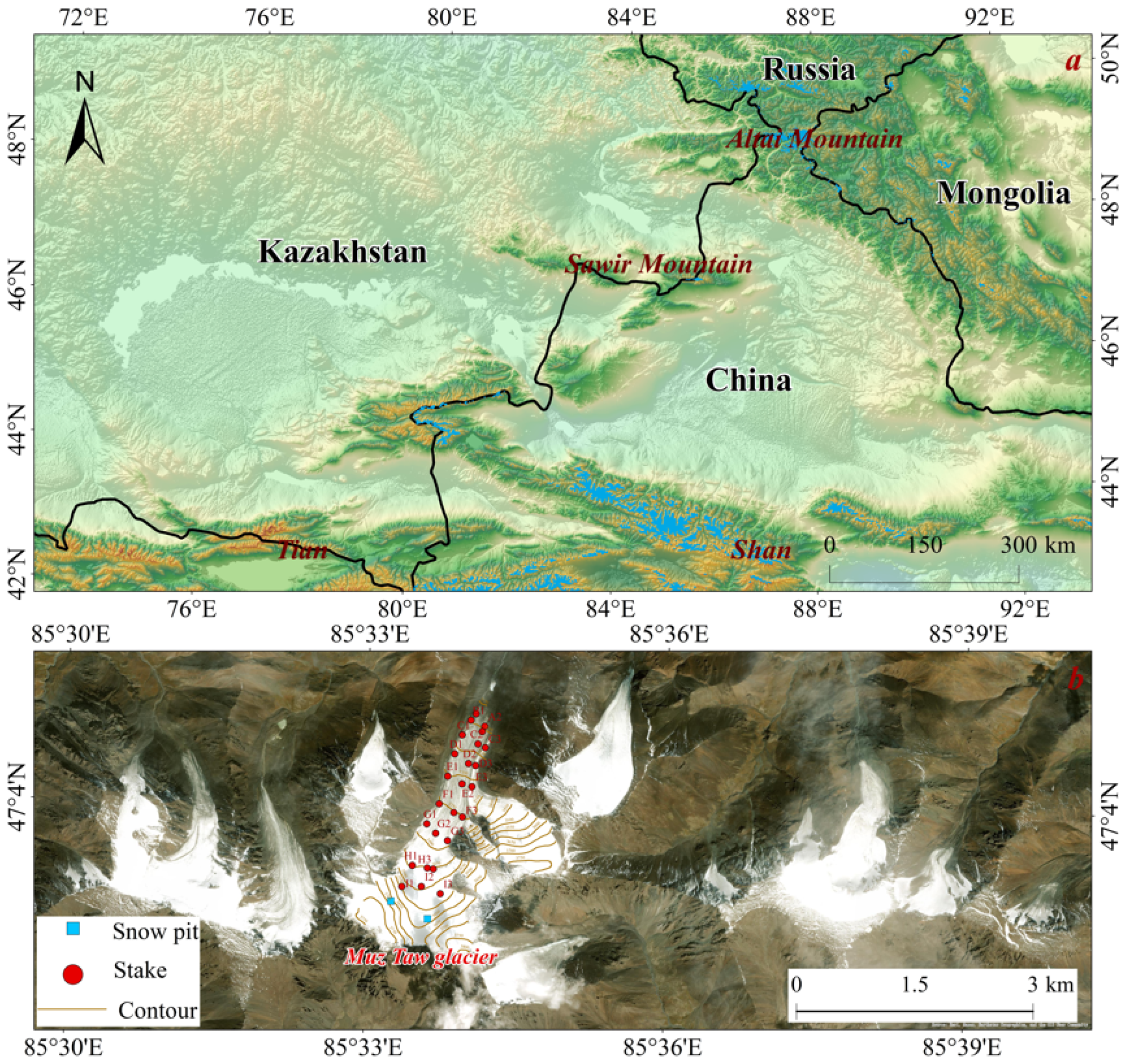
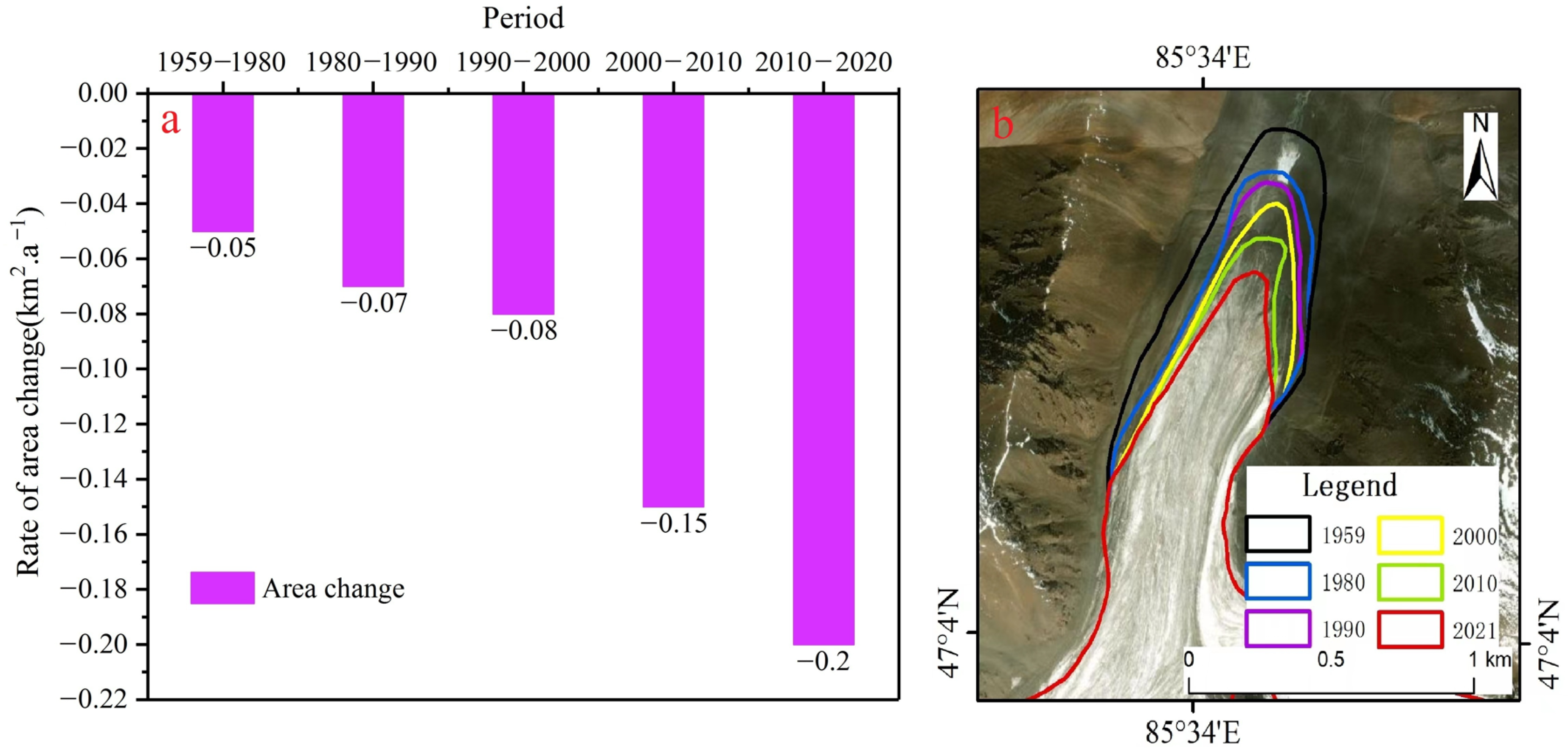

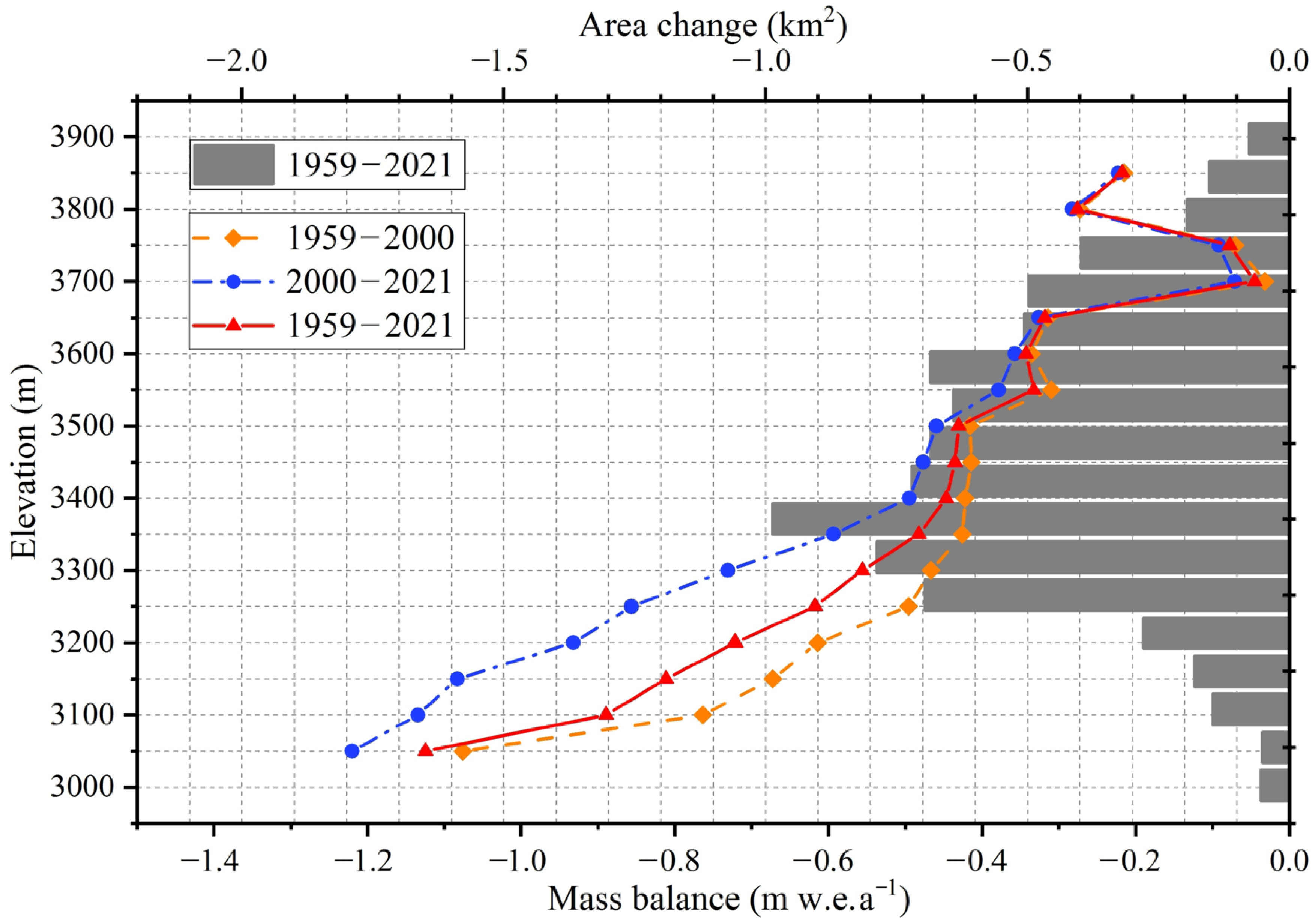
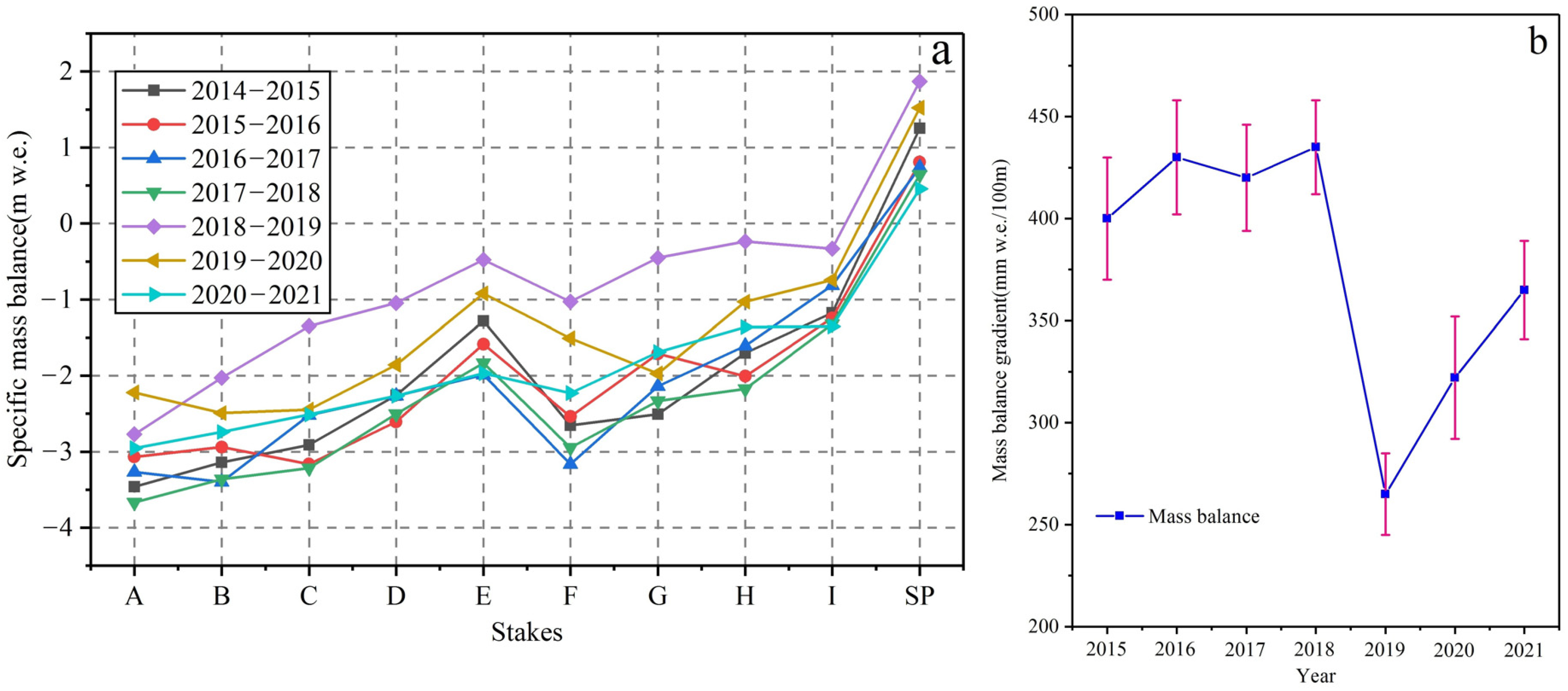
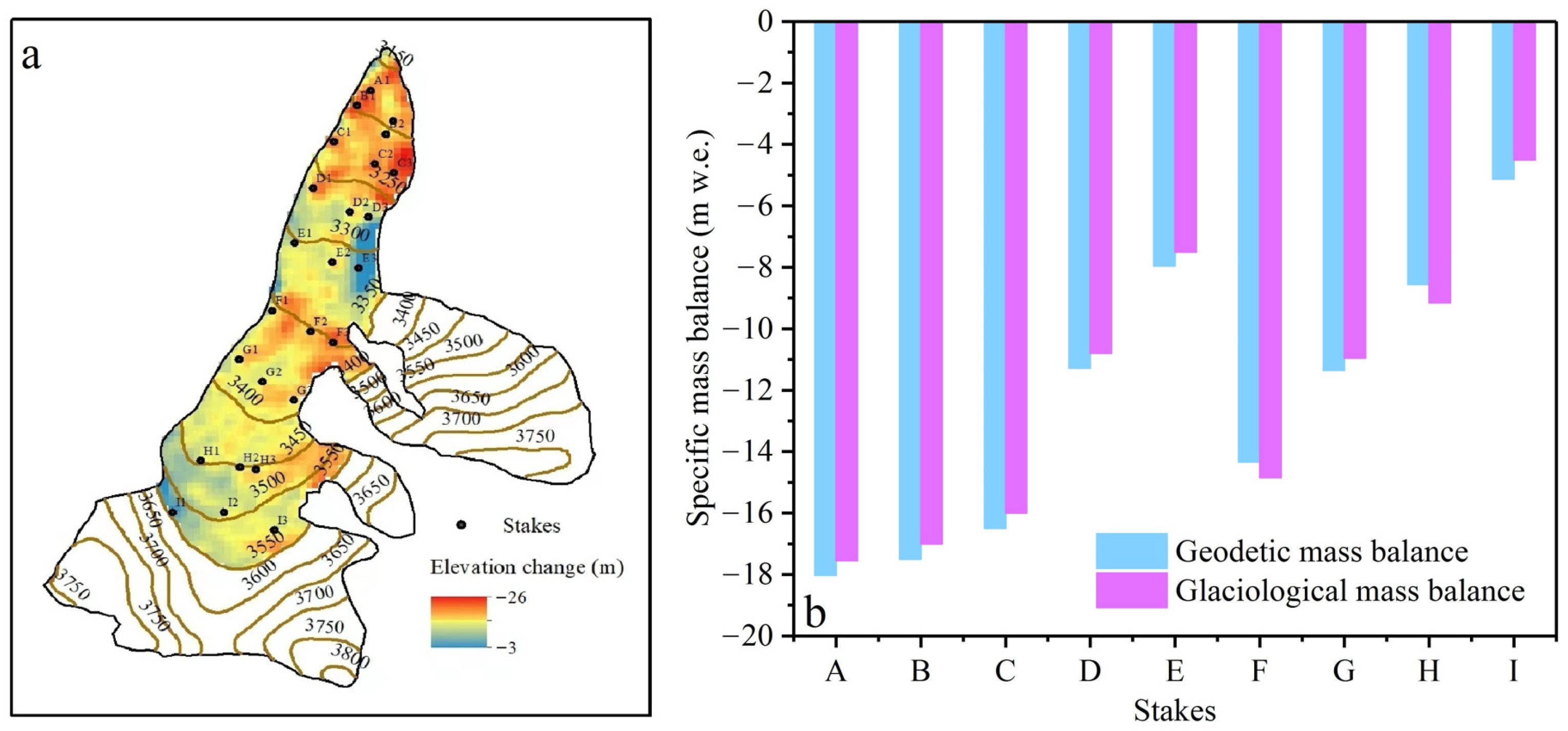
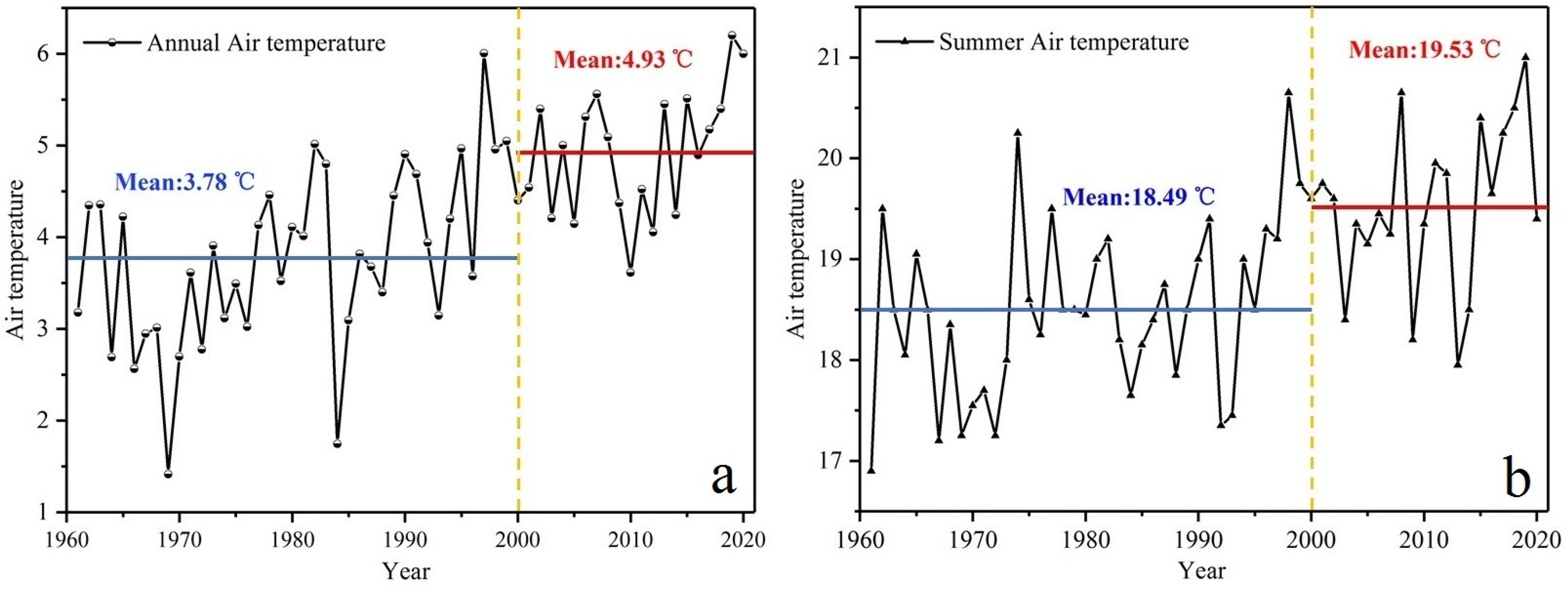
| Data | Scale/Resolution | Date | Application |
|---|---|---|---|
| Topographic map | 1:100,000 | 1959 | DEM and Base image |
| Shuttle Radar Topography Mission DEM Version 4.1(SRTM 4.1) | 30 m | 2000 | DEM |
| ASTER_DEM | 30 m | 2014 | DEM |
| Sentinel−1SAR | 10 m | 2021 | DEM and Base image |
| Landsat Multi-Spectral Scanner (MSS) | 60 m | 1980 | Base image |
| Landsat Thematic Mapper (TM) | 30 m | 1990 | Base image |
| Landsat Enhanced Thematic Mapper (ETM+) | 30 m | 2000; 2010 | Base image |
| Accuracy of DEMs | Offsets in x, y, and z Directions | Before Co-Registration | After Co-Registration | N | SE | E | ||||||
|---|---|---|---|---|---|---|---|---|---|---|---|---|
| n | σDEM | x(m) | y(m) | z(m) | MED | STDVnoglc | MED | STDVnoglc | ||||
| TOPO DEM | 100 | ±0.53 | 22.85 | −1.85 | 0.16 | 14.28 | 48.30 | 0.74 | 36.25 | 14,402 | 0.30 | 0.79 |
| SRTM DEM | 100 | ±0.33 | 15.26 | −0.03 | 0.15 | 4.29 | 21.83 | 0.75 | 12.68 | 18,534 | 0.19 | 0.63 |
| ASTER DEM | 100 | ±0.36 | 12.42 | −0.01 | 0.17 | 2.68 | 27.88 | 0.53 | 15.02 | 19,087 | 0.11 | 0.54 |
| Mountain | Glacier Name | Area (km2) | Altitude (m) | Main Aspect | Annual Air Temperature (°C) | Period | Mass Balance (m w. e. a−1) | Reference |
|---|---|---|---|---|---|---|---|---|
| Altay Mountain | Leviy Aktru glacier | 5.95 | 2665–4030 | northern | −8.2 | 2000–2011 | −0.26 ± 0.1 | [36] |
| Maliy Aktru glacier | 2.73 | 2267–3710 | northern | −6.7 | 2000–2011 | −0.31 ± 0.1 | [36] | |
| Vodopadnity Aktru glacier | 0.98 | 2716–3549 | northern | −6.1 | 2000–2011 | −0.39 ± 0.1 | [36] | |
| Tianshan Mountain | Urumqi glacier No.1 | 1.59 | 3743–4484 | northern | −4.9 | 1981–2015 | −0.46 ± 0.14 | [38] |
| Tuyuksu glacier | 2.28 | 3500–4300 | northern | −6.6 | 1958–2016 | −0.38 ± 0.05 | [38] | |
| Haxilegen Glacier No.51 | 1.18 | 3490–4000 | northeast | −7.4 | 1999–2015 | −0.32 ± 0.22 | [38] | |
| Sawir Mountain | Muz Taw glacier | 2.93 | 3030–3725 | northern | −5.7 | 2014–2021 | −0.88 ± 0.13 | This paper |
Publisher’s Note: MDPI stays neutral with regard to jurisdictional claims in published maps and institutional affiliations. |
© 2022 by the authors. Licensee MDPI, Basel, Switzerland. This article is an open access article distributed under the terms and conditions of the Creative Commons Attribution (CC BY) license (https://creativecommons.org/licenses/by/4.0/).
Share and Cite
Bai, C.; Wang, F.; Bi, Y.; Wang, L.; Xu, C.; Yue, X.; Yang, S.; Wang, P. Increased Mass Loss of Glaciers in the Sawir Mountains of Central Asia between 1959 and 2021. Remote Sens. 2022, 14, 5406. https://doi.org/10.3390/rs14215406
Bai C, Wang F, Bi Y, Wang L, Xu C, Yue X, Yang S, Wang P. Increased Mass Loss of Glaciers in the Sawir Mountains of Central Asia between 1959 and 2021. Remote Sensing. 2022; 14(21):5406. https://doi.org/10.3390/rs14215406
Chicago/Turabian StyleBai, Changbin, Feiteng Wang, Yanqun Bi, Lin Wang, Chunhai Xu, Xiaoying Yue, Shujing Yang, and Puyu Wang. 2022. "Increased Mass Loss of Glaciers in the Sawir Mountains of Central Asia between 1959 and 2021" Remote Sensing 14, no. 21: 5406. https://doi.org/10.3390/rs14215406
APA StyleBai, C., Wang, F., Bi, Y., Wang, L., Xu, C., Yue, X., Yang, S., & Wang, P. (2022). Increased Mass Loss of Glaciers in the Sawir Mountains of Central Asia between 1959 and 2021. Remote Sensing, 14(21), 5406. https://doi.org/10.3390/rs14215406







